The effectiveness of a proposed strategy based on Guilford’s theory in achieving history for the first intermediate grade
Main Article Content
Abstract
The aim of the research is to analyze the effectiveness of the proposed strategy based on Guilford's theory in achieving the history curriculum for the first intermediate grade. The researcher relied on an experimental design, where the students were divided into an experimental group and a reference group. The research community consisted of all first-grade middle school students in schools affiliated with the Baghdad Education Directorate. A representative sample was chosen, consisting of the experimental group (25) students who received the strategy that was proposed based on Guilford’s theory, and the reference group was (26) students who received the usual methodology.
A history curriculum achievement exam consisting of (25) items was used as a data collection tool and was of a multiple-choice type. Its validity, reliability, level of difficulty of the items, and power of discrimination were studied before implementing it on the two sections according to appropriate statistical treatments. The results showed that the students in the experimental group who received the proposed strategy according to Guilford's theory achieved improvement in the achievement test compared to the students in the reference group who learned with the traditional methodology.
Based on these results, it can be said that the proposed strategy based on Guilford's theory has positively affected students' achievement in history. Therefore, schools can be recommended to adopt this strategy in teaching this subject to achieve better results for students.
According to the research outcomes, the researcher included a number of recommendations for exploiting Guilford’s theory in teaching the history curriculum, including activating students to exploit imagination and creativity in perceiving historical events in a different and multiple way and presenting new visions, diversifying educational mechanisms and using multiple educational methods that cover discussions, responsive activities, and research plans to support the experience. Learning.
Metrics
Article Details

This work is licensed under a Creative Commons Attribution 4.0 International License.
College of Education for Humanities, TIKRIT UNIVERSITY. THIS IS AN OPEN ACCESS ARTICLE UNDER THE CC BY LICENSE http://creativecommons.org/licenses/by/4.0/
References
Abdel Aziz, Hessa (2017): Analysis of the implementation of design thinking and reflection plans in teaching and the completion of educational endeavors.
Abu Khudair, Khamail Shaker Nazzal, Haid Khazal (2018): The effect of teaching the ancient history curriculum using a participatory teaching strategy on the acquisition of vocabulary for the first stage, College of Basic Education, Department of History, Baghdad.
Ahmed, Hazem Majeed, Yass and Sahib, Asaad (2012): Reasons for the low level of achievement among secondary school students from the point of view of male and female teachers and students, Sir Man Ra’a Magazine, Volume Eight, Issue 28, Tikrit University.
Ahmed, Muhammad (2016): Analysis of education mechanisms and their impact on learners’ achievement.
Ali, Sarah (2019): Implementing contemporary mechanisms in teaching.
Al-Jalali: Laman Mustafa (2011): Collection, Dar Al-Masirah for Publishing and Distribution, Amman.
Al-Khalaf, Abbas (2023): Effective Teaching of History at the Secondary Level, General Directorate of Teacher Preparation, Training and Educational Development/Ministry of Education, Appendix 84.
Al-Zaanin, Jamal Abd Rabbo Ali (2011): The effect of plans for solving verbal physics problems according to the Guilford model in consolidating physical mental abilities, International Journal of Educational Research, Issue 29.
Hayawi, Firas Salim Faleh, Haid Hatem (2015): The impact of Polya’s strategy on the acquisition of the subject of the history of Arab-Islamic civilization in the vocabulary of the fourth grade. Baghdad.
Jaber, Abdel Hamid Jaber (1999): Mechanisms of Teaching and Learning, Dar Al-Fikr Al-Arabi for Publishing and Distribution, Cairo.
Jarry, Khudair Abbas (2017): Advanced studies in curricula and methods of teaching social studies on samples from Iraqi society, 2nd edition, Dar Al-Farahidi for Publishing and Distribution, Baghdad.
Khaled, Laila (2020): Educational mechanisms and its impact on strengthening the creative capabilities of learners.
Khalil, Samaa Alaa (2024): Employing artificial intelligence in teaching the history subject “Negatives and Positives”, Iraqi University, Issue (65, Part 3).
Muhammad, Omar (2018): Reflection on the exploitation of active learning practices in strengthening education mechanisms.
Zafar, Hatem and Fadil Daoud Franso (2021): Designing an educational program based on Guilford’s theory to establish higher thinking and contemplation abilities among primary school teachers, Mosul.
المراجع الأجنبية:
Guilford , J, P (1971): The Analysis of Intelligence" Co-authored with Ralph H. Hoppner, this book delves into intelligence analysis, providing insights into its structure and components.
Herschbach, Dennis R (2016): Practical Assessment and Evaluation: Essential Techniques for Teachers"
Kelly , T. Mills (2013): Teaching History in the Digital Age"
Suskie, Linda (2019): Assessing Student Learning: A Common Sense Guide"




